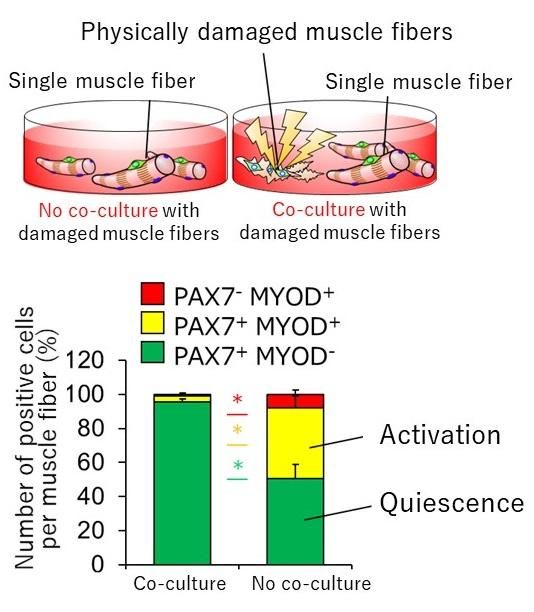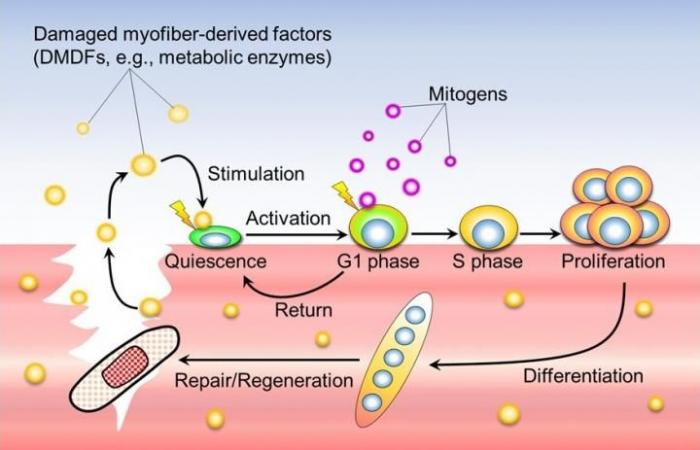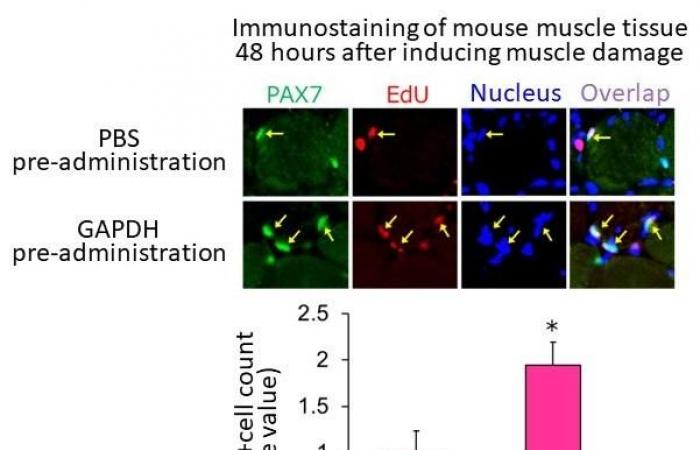In building a muscle damage model in a cultured system, a research collaboration between Kumamoto University and Nagasaki University in Japan found that components leaked from broken muscle fibers activate “satellite” muscle stem cells. While trying to identify the proteins that activate satellite cells, they found that metabolic enzymes like GAPDH quickly activated dormant satellite cells and accelerated the regeneration of muscle injuries. This is a very rational and efficient regeneration mechanism in which the damaged muscle itself activates the satellite cells that begin the regeneration process.
Skeletal muscle is made up of bundles of contracting muscle fibers, and each muscle fiber is surrounded by satellite cells – muscle stem cells that can produce new muscle fibers. Thanks to the work of these satellite cells, muscle fibers can be regenerated even after a bruise or a tear during intensive training. Satellite cells also play an essential role in muscle growth in developmental stages and in muscle hypertrophy during strength training. In refractory muscle diseases such as muscular dystrophy and age-related muscle fragility (sarcopenia), however, the number and function of satellite cells decrease. It is therefore important to understand the regulatory mechanism of satellite cells in muscle regeneration therapy.
In mature skeletal muscle, satellite cells are usually present in a dormant state. When stimulated after muscle injury, satellite cells are activated quickly and multiply repeatedly. During the subsequent myogenesis, they differentiate and regenerate muscle fibers by fusing with existing muscle fibers or with one another. Of these three steps (activation, proliferation, and muscle differentiation of satellite cells), little is known about how the first step, activation, is induced.




Since satellite cells are activated when muscle fibers are damaged, the researchers hypothesized that muscle damage itself could trigger activation. However, this is difficult to demonstrate in animal models of muscle injury, so they constructed a cell culture model in which individual muscle fibers isolated from mouse muscle tissue were physically damaged and destroyed. Using this injury model, they found that components leaking from the injured muscle fibers activated satellite cells, and the activated cells entered the G1 preparatory phase of cell division. Further, the activated cells returned to a dormant state when the damaged components were removed, suggesting that the damaged components were acting as activation switches.
The research team named the leaky components “Damaged Myofiber Derived Factors” (DMDFs) after the broken muscle fibers and identified them using mass spectrometry. Most of the proteins identified were metabolic enzymes, including glycolytic enzymes such as GAPDH, and muscle anomaly enzymes, which are used as biomarkers of muscle disorders and diseases. GAPDH is known as the “moonlight protein” which, in addition to its original role in glycolysis, also plays other roles, such as: B. the control of cell death and the mediation of immune responses. The researchers therefore analyzed the effects of DMDFs, including GAPDH, on the activation of satellite cells and confirmed that exposure led to their entry into the G1 phase. In addition, the researchers injected GAPDH into the skeletal muscle of the mouse and observed accelerated proliferation of satellite cells after subsequent drug-induced muscle damage. These results suggest that DMDFs are able to activate dormant satellite cells and induce rapid muscle regeneration after injury. The mechanism by which broken muscles activate satellite cells is a powerful and efficient mechanism for tissue regeneration.
“In this study, we proposed a new model for muscle injury recovery. However, the detailed molecular mechanism of how DMDFs activate satellite cells remains an unclear topic for future research. In addition to activating satellite cells, the DMDF moonlight functions are expected to be diverse, ”said Associate Professor Yusuke Ono, head of the study. “Recent studies have shown that skeletal muscles secrete various factors that affect other organs and tissues such as the brain and fat into the bloodstream. Therefore, it is possible that DMDFs are involved in the connection between injured muscles and other organs through blood flow. We believe that further elucidation of the functions of DMDFs could clarify the pathologies of some muscle diseases and help in the development of new drugs. ”
research
These were the details of the news Damaged muscles don’t just die, they regenerate – Global Health News... for this day. We hope that we have succeeded by giving you the full details and information. To follow all our news, you can subscribe to the alerts system or to one of our different systems to provide you with all that is new.
It is also worth noting that the original news has been published and is available at de24.news and the editorial team at AlKhaleej Today has confirmed it and it has been modified, and it may have been completely transferred or quoted from it and you can read and follow this news from its main source.



